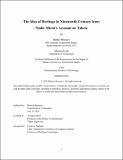The Idea of Heritage in Nineteenth-Century Iran: Nādir Mīrzā’s Account on Tabriz
Author(s)
Moossavi, Boshra
DownloadThesis PDF (2.533Mb)
Advisor
Dutta, Arindam
Terms of use
Metadata
Show full item recordAbstract
This thesis focuses on the concept of heritage and its preservation in nineteenth-century Iran through the perspective of Prince Nādir Mīrzā Qajar (1827-1888/9). While heritage and preservation have been extensively studied in the Euro-American context, little attention has been given to their meanings in the non-Western discourses, particularly in Iran. The few studies on Iran focuses on the institutionalization of heritage and the Western influences on it by Europeans and Iranian reformists. This research seeks to provide a fresh perspective on the idea of heritage for non-reformist groups of people who were rooted in the religious and cultural traditions of Iran. To this end, Nādir Mīrzā, as a Qajar prince whose writing reflects traditional Iranian patterns of thought, was selected for this study. By an in-depth investigation of Nādir Mīrzā’s The History and Geography of Tabriz, I shed light on the difference between Nādir Mīrzā’s understanding of architecture and what later was promoted as heritage by the Society for National Heritage in the twentieth century. The manuscript belongs to the antiquarian category of texts that focus on history and geography in tribute to rulers and princes. However, unlike other works of this genre that mainly consist of chronicles and descriptions, I would contend that The History and Geography of Tabriz offers insight into a broader era of decay of the traditional built environment in Qajar Iran. Moreover, the city of Tabriz, situated near the Ottoman Empire and inhabited predominantly by Azari speakers, is significant from a strategic and ethnic point of view.
To this end, I examine Nādir Mīrzā’s background, including his family lineage, education, and writing style, to understand how his understanding of heritage was shaped. Then I investigate how Nādir Mīrzā’s writing is a form of heritage as it attempts to preserve certain aspects of history. Therefore, how religion, class, linguistic, and ethnic identities influenced his choice for historicizing the past. Then, following a brief mention to the reformists’ values on heritage, I uncover Nādir Mīrzā’s specific values by analyzing his accounts of buildings. Finally, I investigate the role of those values in preservation and maintenance of buildings through extracting the reasons for construction, repair, and destruction from Nādir Mīrzā’s accounts. The conclusion proposes further investigation into other sources to complete the narrative of non-European understanding of heritage in nineteenth-century Iran.
Date issued
2023-09Department
Massachusetts Institute of Technology. Department of ArchitecturePublisher
Massachusetts Institute of Technology